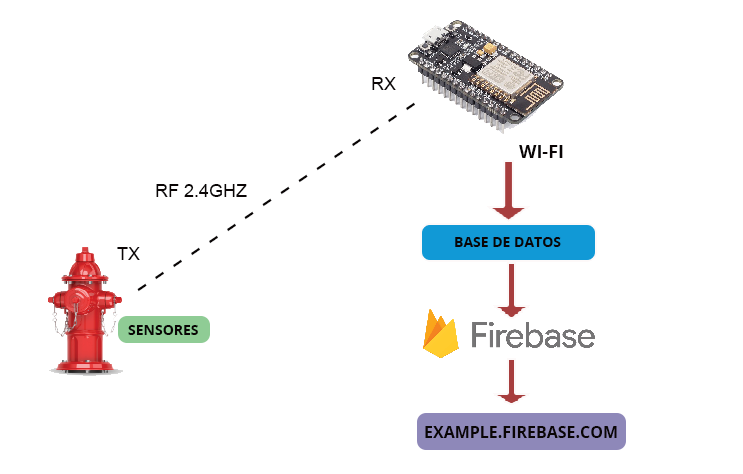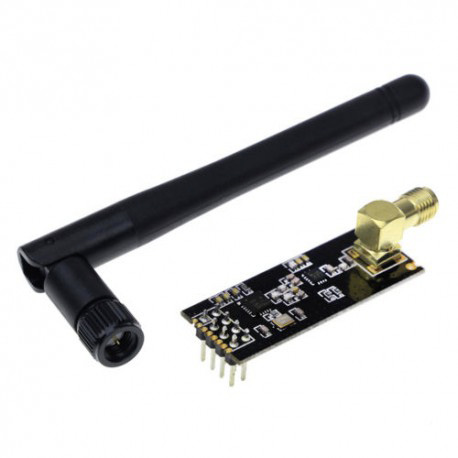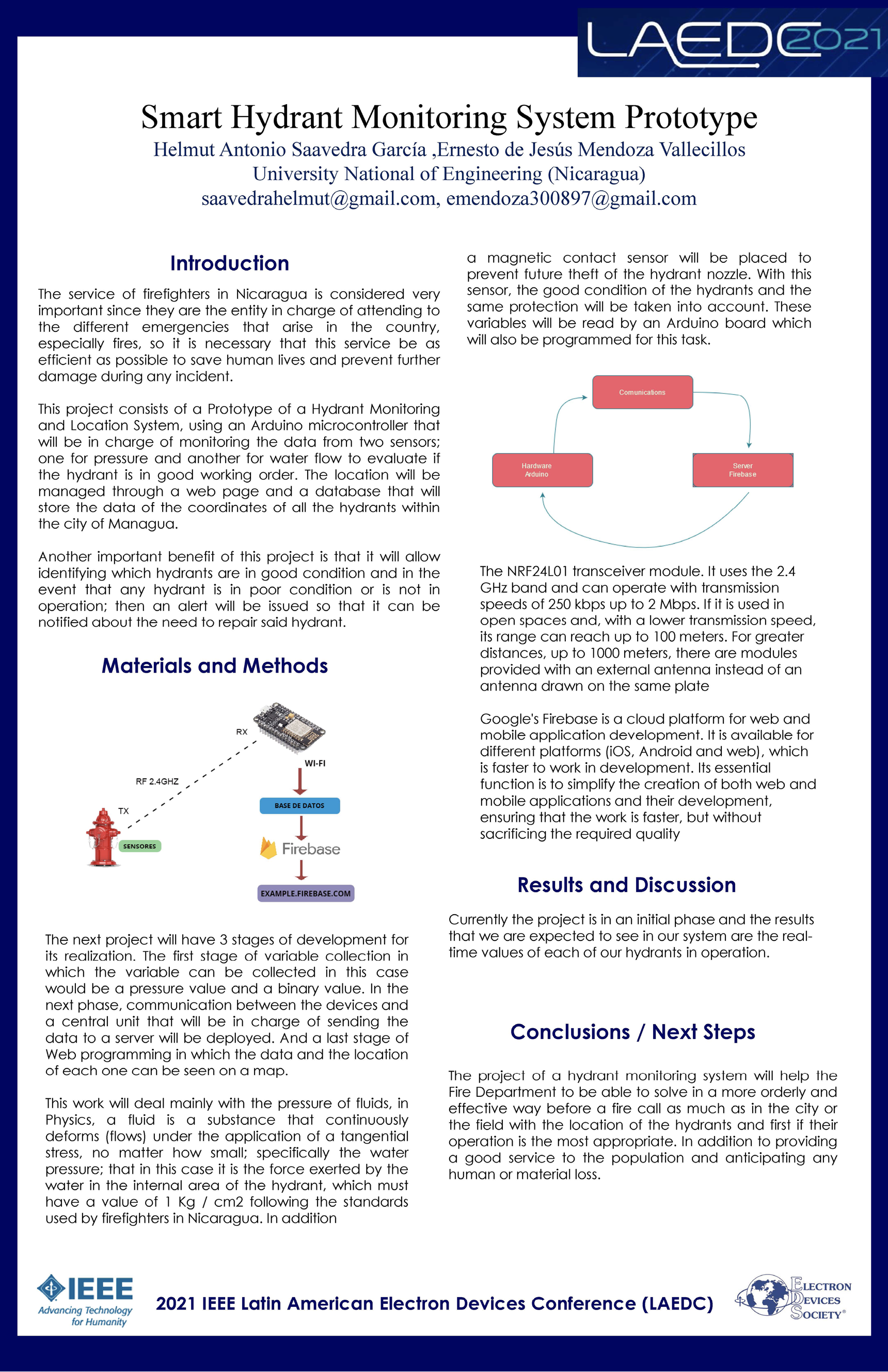Smart Hydrant Monitoring System Prototype
Prototipo de un sistema inteligente de monitoreo de hidrante
Helmut Antonio Saavedra-García1, Ernesto de Jesús Mendoza-Vallecillo2
Saavedra-García, H. A; Mendoza-Vallecillo, E. J. Smart hydrant monitoring system prototype. Tecnología en Marcha. Vol. 34, especial. Noviembre LAEDC 2021. Pág 17-22. https://doi.org/10.18845/tm.v34i6.5969
https://doi.org/10.18845/tm.v34i6.5969
Keywords
Firebase; Python; Flask; hydrants; arduino.
Abstract
In this article we will develop a system that allows the monitoring of hydrants through an Arduino microcontroller in the city of Managua. Which will consist of 3 stages. A Stage of Sensors and Actuators, Communication Stage and Server Configuration. Which can be monitored from a subdomain of the Firebase platform.
Palabras clave
Firebase; Python; Flask; hidrantes; arduino.
Resumen
En el presente artículo se desarrollara un sistema de que permita el monitoreo de los hidrantes mediantes un microcontrolador Arduino en la cuidad de Managua. El cual constara de 3 etapas. Una etapa de Sensores y Actuadores, Etapa de Comunicación y una de configuración del servidor. El cual se podra monitorear desde un subdominio de la plataforma de Firebase.
Introduction
Hydrants are useful tools in any city, since they are used mainly by firefighters to attend to the different emergencies that arise. In the case of Nicaragua, the company that is in charge of the control, installation and maintenance of the hydrants is Nicaraguan company of aqueducts and sanitary sewers (ENACAL), so it is necessary that this company have an efficient system that allows it to keep a good control of the hydrants so that the firefighters They can have them in their work and not have difficulties in this process.
In Nicaragua there were approximately 3 fires a day for the year 2017, we can also say that the places in which these fires occurred were not in operation the nearby hydrants, among the possible reasons were:
•Fire hydrants in poor condition
•Nozzles which the hose connects damaged
•There were no Nearby Hydrants in the place.
This makes it difficult to find a hydrant in operation since, due to the lack of adequate attention from the competent authorities (ENACAL), these can often be found damaged or out of operation, making emergency attention service more difficult by of firefighters, which causes them to be delayed in their work to attend to different emergencies, especially in fires, since in these cases response time is vital.
Currently ENACAL uses citizen alerts to identify the state of hydrants, this often implies that ill-intentioned people can make false notifications, therefore the authorities in charge do not take these reports seriously.
Therefore ENACAL carries out an annual schedule by a crew to check the status of the hydrants. However, these scheduling plans are no longer viable due to the response time that is needed when an emergency occurs, so that the current systems that ENACAL works with are obsolete.
This project consists of a Prototype of a Hydrant Monitoring and Location System, this through an Arduino microcontroller that will be in charge of monitoring the data from two sensors; one of pressure and another of the water flow to evaluate if the hydrant is in good working order. The location will be managed through a web page and a database that will store the data of the hydrants coordinates within the city of Managua.
Another important benefit of this project is that it seeks to identify which hydrants are in good condition and in case any hydrant is in poor condition or is not in operation; then an alert will be issued so that it can be notified about the need to repair said hydrant.
Methods
The next project will have 3 stages of development for its realization. The first stage of variable collection in which the variable can be collected in this case would be a pressure value and a binary value. In the next phase, communication between the devices and a central unit that will be in charge of sending the data to a server will be deployed. And a last stage of Web programming in which the data and the location of each one can be seen on a map. A as shown in figure 1.

Figure 1. Hydrant Monitoring Concept Diagram.
Sensor and actuator stage
This work will deal mainly with the pressure of fluids, in Physics, a fluid is a substance that continuously deforms (flows) under the application of a tangential stress, no matter how small; specifically the water pressure; that in this case it is the force exerted by the water in the internal area of the hydrant, which must have a value of 1 Kg / cm2 following the standards used by firefighters in Nicaragua.
In addition, a magnetic contact sensor will be placed to prevent future theft of the hydrant nozzle. With this sensor, the good condition of the hydrants and the same protection will be taken into account. These variables will be read by an Arduino board which will also be programmed for this task.
Figure 2 shows the NRF24L01 transceiver module. It uses the 2.4 GHz band and can operate with transmission speeds of 250 kbps up to 2 Mbps. If it is used in open spaces and, with a lower transmission speed, its range can reach up to 100 meters. For greater distances, up to 1000 meters, there are modules provided with an external antenna instead of an antenna drawn on the same plate [5].

Figure 2. NRF24L01 transceiver module.
This module will be very useful since it will allow communication via radio frequency (RF) between the Arduino Uno and the sensors to the ESP8266 module.
Google’s Firebase is a cloud platform for web and mobile application development. It is available for different platforms (iOS, Android and web), which is faster to work in development. Its essential function is to simplify the creation of both web and mobile applications and their development, ensuring that the work is faster, but without sacrificing the required quality. [2]
One of the most prominent and essential tools in Firebase is real-time databases. These are hosted in the cloud, are Non-SQL, and store the data as JSON. They allow to host and have the data and information of the application in real time, keeping them updated even if the user does not take any action.
Firebase automatically sends events to applications when data changes, storing the new data to disk. Even if there was no connection from a user, their data would be available to the rest and the changes made would be synchronized once the connection is reestablished.
Through Firebase, the system database will be designed that will handle the different data used, such as the values extracted from the sensors and the coordinates of the hydrant locations.
The programming of the web page will be done with the use of the Python language and the framework that will be Flask.
Conclusion
The project of a hydrant monitoring system will help the Fire Department to be able to solve in a more orderly and effective way before a fire call as much as in the city or the field with the location of the hydrants and first if their operation is the most appropriate. In addition to providing a good service to the population and anticipating any human or material loss.
References
[1] Flask, «Flask,» 2010. [En línea]. Available: https://flask.palletsprojects.com/en/1.1.x/. [Último acceso: 2021].
[2] E. N. Diario, «El Nuevo Diario,» 2017. [En línea]. Available: https://www.elnuevodiario.com.ni/nacionales/452653-313-incendios-forestales-agricolas-2017/.
[3] Sparkfun, «Spakfun,» Marzo 2006. [En línea]. Available: https://www.google.com/url?sa=t&rct=j&q=&esrc=s&source=web&cd=&ved=2ahUKEwjL9K-S9NHvAhVlu1kKHXLODp8QFjAAegQIBRAD&url=https%3A%2F%2Fwww.sparkfun.com%2Fdatasheets%2FComponents%2FnRF24L01_prelim_prod_spec_1_2.pdf&usg=AOvVaw1BfcUgKixt-goxYYX0I7Nx.
[4] Firebase, «Firebase,» 2021. [En línea]. Available: https://firebase.google.com/docs. [Último acceso: 2021].
[5] El Mundo, «El mundo,» 8 Junio 2018. [En línea]. Available: https://www.elmundo.cr/municipales/heredia-primera-provincia-en-tener-hidrantes-inteligentes/.

Ilustration 1. Presented Poster at LAEDC 2021.
1 Universidad Nacional de Ingeniería, Nicaragua.
Email: saavedrahelmut@gmail.com https://orcid.org/0000-0001-8592-8358
https://orcid.org/0000-0001-8592-8358
2 Universidad Nacional de Ingeniería, Nicaragua.
Email: emendoza300897@gmail.com https://orcid.org/0000-0002-2814-9283
https://orcid.org/0000-0002-2814-9283